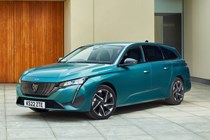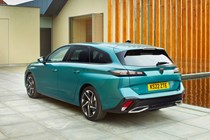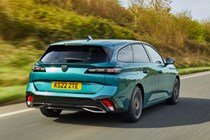
Peugeot 308 SW review
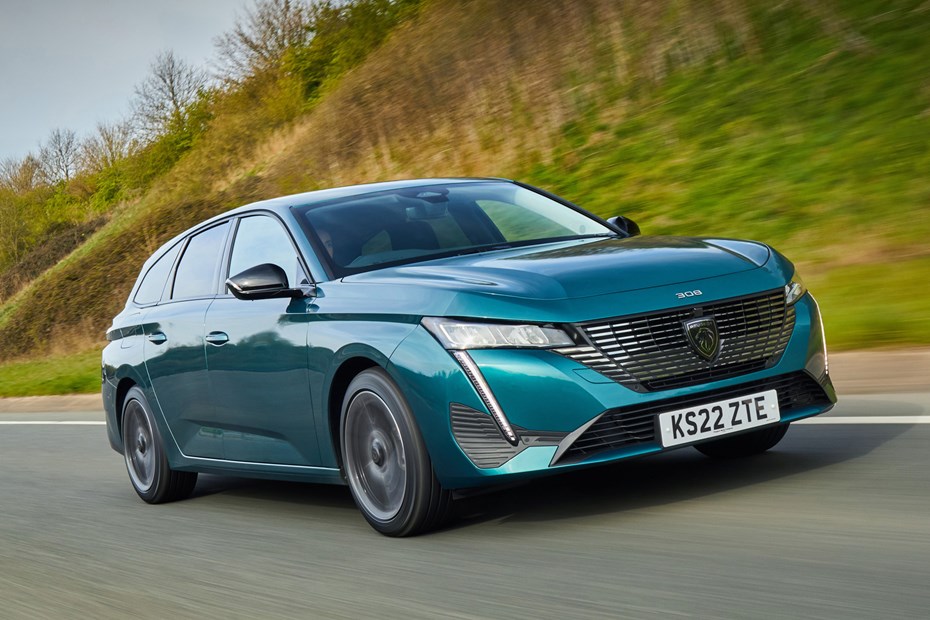
At a glance
| Price new | £33,245 - £42,630 |
|---|---|
| Used prices | £7,368 - £26,950 |
| Road tax cost | £195 - £620 |
| Insurance group | 18 - 30 |
Get an insurance quote with

|
|
| Fuel economy | 42.3 - 65.6 mpg |
| Miles per pound | 6.2 - 9.2 |
| Number of doors | 5 |
| View full specs for a specific version | |
Available fuel types
Petrol
Diesel
Hybrid
Pros & cons
- Longer wheelbase improves ride over the hatch
- Upmarket interior and excellent build quality
- Loads of boot space – 1,634 litres in total
- Not particularly engaging to drive
- Seating position won’t suit taller drivers
- PHEVs aren’t as efficient as Peugeot claims
Overview
We’ve already driven the hatchback version of the latest Peugeot 308, which we found to be a bit of a marmite motor. We loved the car’s clever infotainment system, spacious interior and solid build quality, but found its unusual driving position, uninspiring handling and harsh suspension difficult to get along with.
After handing back the keys for the hatch, we jumped behind the wheel of the 308 SW estate – and we reckon that it’s the better buy. In fact, we rate it as one of the best hybrid estates on the market.
Admittedly, you still have to contend with the strange steering wheel placement but, because it has a slightly longer wheelbase, it’s a little more practical and it rides a lot better.
The 308 estate isn’t even that much more expensive than the standard car. Prices start from £26,470, which is a mere £1,200 more than the hatchback. You also have the same range of engines and trims available to you – and in 2023, Peugeot will release an electric version of the car with a maximum range of around 250 miles.
What’s better about the estate?
We’ll break it down. The estate’s wheelbase (that’s the distance between the front and rear axles) measures 2,735mm, compared to 2,680mm in the hatchback. Rear legroom doesn’t change, but you do get some more headroom as the estate’s roof doesn’t taper as much.
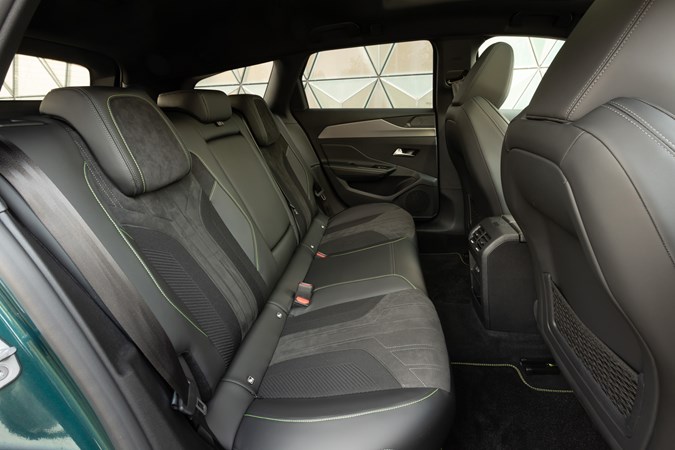
Boot space increases from 412 litres to 608 litres with the rear bench in place, and the load area is a lot longer which makes the SW considerably more practical for families. If you’re heading away for the weekend with a newborn, you can fire your suitcases, assorted baby clobber and pram into the back of the 308 without folding the bench. Which is handy.
The extra wheelbase also seems to suit the 308’s chassis better. As well as riding better than the hatchback, the estate is also more stable. The standard 308 has a tendency to move around over uneven tarmac as the chassis hunts for grip, but the estate feels a lot more planted meaning you can hustle down B-roads faster.
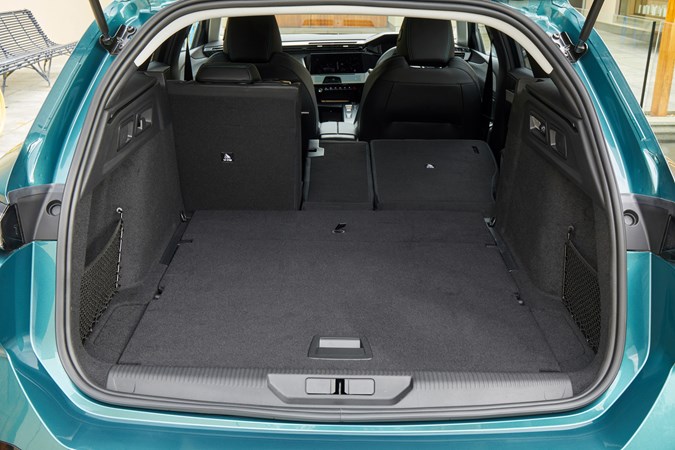
Peugeot has also managed to make the estate feel as agile as the hatchback. Despite being bigger and heavier, it’s equally eager to turn in – especially if you specify it with the brand’s lightweight 1.2-litre three-cylinder petrol engine. It still isn’t the most engaging car to drive in the class, but it improves on the benchmark set by the hatch.
What about the things that haven’t changed?
The estate shares the same weird driving position as the hatchback. It’s divided opinion in the office – and how comfortable you find it will ultimately depend on how tall you are. The steering wheel is mounted low and the seat is set quite high, which means if you adjust the wheel to a position that’s comfortable for your arms it blocks the gauges.
Not being able to see how fast you’re going is a serious issue, but there’s a secondary effect to the layout. It doesn’t really give you the confidence to drive the 308 enthusiastically, which disagrees with the way Peugeot has set up the car’s chassis. The suspension’s quite stiff and the steering is quick, making the car feel more like a hot hatch than a family runabout.
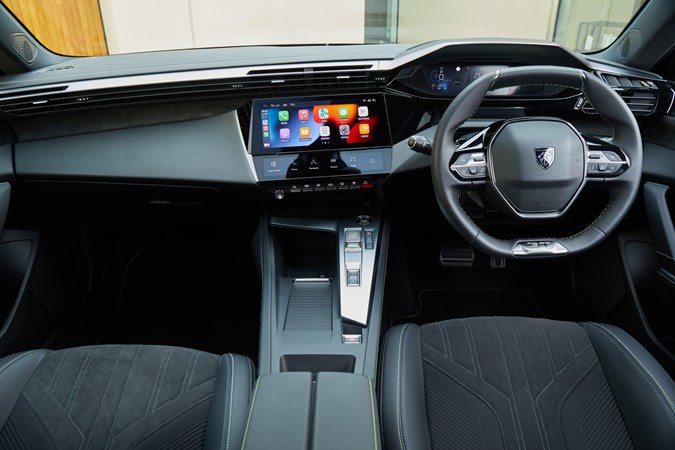
If you’re over six feet tall (like our tester), the only way to drive the 308 is to have the wheel and the seat set in their lowest positions to give a clear view of the gauges. However, with these settings, we found that if you’re braking while turning at a junction, your hands will make contact with your knees and prevent you from rounding the bend. It’s a little irritating.
Thankfully, Peugeot hasn’t fiddled with the 308 SW’s dashboard. It gets the same 10-inch infotainment system as the hatch – and it’s an absolute corker. The graphics look as crisp as those of a modern smartphone and there’s a strip of customisable shortcut buttons under the screen which allow you to jump to any function that’s accessible through the screen.
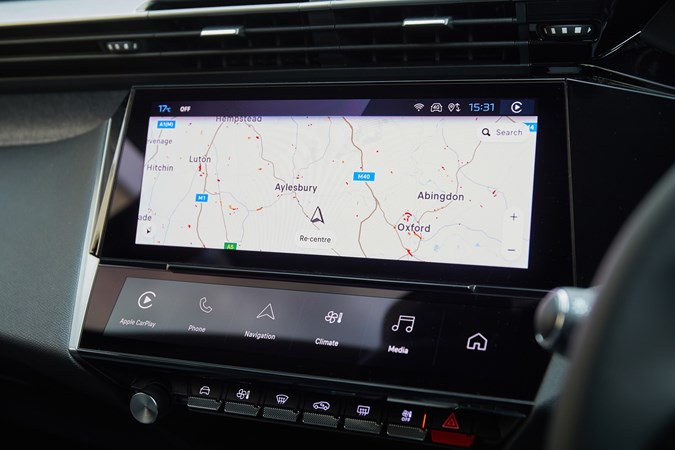
Peugeot calls them “i-Toggles,” and they really can be programmed to access any setting you can dream up. If you wanted, you could have one widget that disengages the lane-keep assist, one which plays heavy metal through the stereo and another that sets the sat-nav to your local chippy. It’s a fun and useful addition to the interior.
What engines are there?
You have four choices for the time being. The entry-point to the 308 SW range is a 1.2-litre three-cylinder petrol unit with 130hp and 170Nm of torque. Like every combustion engine in the 308’s line-up, it’s mated to an eight-speed automatic gearbox.
We think the 1.2-litre petrol is definitely the sweet spot in the range. It’s very eager, offering enough torque in the mid-range to allow you to overtake with confidence. It’s also shockingly smooth for a three-cylinder engine – when cruising, you can barely hear in the cabin.
It even sounds quite good when you hammer the throttle and, because it’s so light, it doesn’t push the 308’s nose wide when cornering. Our only complaint is the automatic gearbox. It does a good job of keeping the engine quiet, but it isn’t as smooth as a Volkswagen DSG and it can be a little slow to change down when you put your foot to the floor.
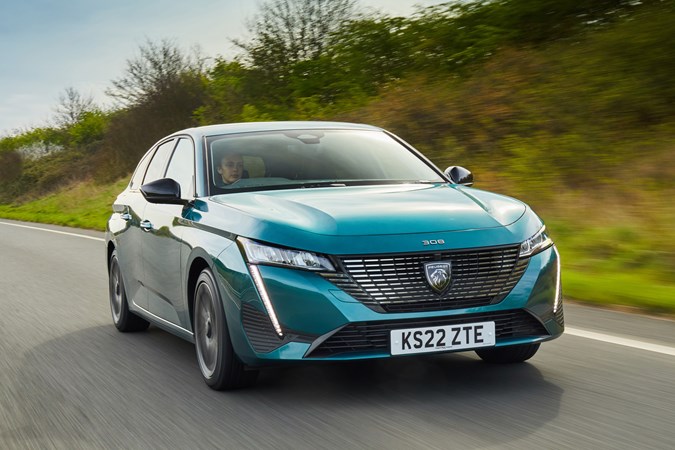
Here’s the real kicker, though – the 308 estate posted identical fuel economy figures to the hatchback in the most recent round of WLTP testing. Peugeot claims it’ll return between 43.5–52.1mpg. When driving carefully, we saw figures in the high-40s on the trip computer.
There’s just one diesel option. It’s a 1.5-litre four-cylinder unit with 130hp and 300Nm of torque, which looks very impressive. However, the engine feels more lethargic than you would expect and it’s quite noisy when you ask for full throttle. In-gear acceleration isn’t exactly sparkling, while the extra weight dulls the car’s handling.
And the plug-in hybrids?
Two options here, both based around the same 1.6-litre four-cylinder petrol engine. The cheaper model has an output of 180hp, while the flagship variant gets 225hp. The torque figure is identical for both powertrains at 320Nm.
They both feel pretty brisk, but they’re both held back by software that’s as thick as two short planks. There’s a good two-second delay between flooring the throttle and acceleration, as you wait for the gearbox to decide on the correct cog and for the electric motor to awake from its slumber. By which point, you’ve missed your overtaking chance.
After spending some time with both plug-in hybrid systems, we’re also struggling to see the appeal of the more powerful one. Because both powertrains produce the same amount of torque, the 225hp model doesn’t feel any faster than the 180hp version – and Peugeot’s performance figures confirm our assumption.

The former is only 0.1 seconds quicker from 0–62mph than the latter, and we’re not sure whether marginal gains like that are worth spending an extra £3,300 on. You have to make the jump from the company’s mid-range Allure trim to its sporty GT specification to gain access to the more potent powertrain, hence the big jump in price.
It isn’t all bad, though. The PHEV system is refined enough while cruising and Peugeot says the system’s 12.4kWh battery pack can store enough electricity for a maximum range of 44 miles in EV. That’s more than enough for the average UK commuter.
We fear Peugeot may have overestimated the 308 PHEV’s economy figures, though. The company says the estate managed more than 280mpg during WLTP testing, but we didn’t come anywhere near those figures in the real world. We averaged around 50–60mpg with the battery charged, but once we’d emptied the cells the PHEV’s economy became considerably worse than the pure petrol-powered variant.



